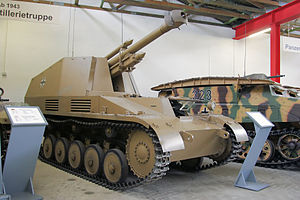Wespe
| Wespe | |
|---|---|
 Wespe at the Deutsches Panzermuseum in Munster, Germany | |
| Type | Self-propelled artillery |
| Place of origin | |
| Service history | |
| In service | 1943 - 1945 |
| Wars | World War II |
| Production history | |
| Designer | Alkett |
| Produced | 1943 - 1944 |
| No. built | 662 |
| Variants | ammunition carrier |
| Specifications | |
| Mass | 11 tonnes (24,250 lbs) |
| Length | 4.81 metres (15 ft 9 in) |
| Width | 2.28 metres (7 ft 6 in) |
| Height | 2.3 metres (7 ft 7 in) |
| Crew | 5 (commander, driver, three gunners) |
| Armor | 5 - 30 mm (.19 - 1.18 in) |
Main armament | 1x 10.5 cm leFH 18M L/28 with 32 rounds |
| Engine | 6-cyl petrol Maybach HL62TR 140 hp (105 kW) |
| Power/weight | 12.7 hp/tonne |
| Suspension | leaf spring |
Operational range | 220 km (137 mi) |
| Maximum speed | 40 km/h (25 mph) |
The SdKfz 124 Wespe (German for "wasp"), also known as (Leichte Feldhaubitze 18 auf Fahrgestell Panzerkampfwagen II was a German self-propelled artillery vehicle developed and used during the Second World War. It was based on the Panzer II tank.
Development
In 1940, during the Battle of France, it was apparent that the main tank of the German forces, the Panzer II, was unsuitable as tank; though mechanically sound, it was both under-gunned and under-armoured. Thus, when the need arose for a self-propelled artillery vehicle, the Panzer II was a natural choice, removing the vehicles from front line service and extending their usable lifespan.
The design for the Wespe was produced by Alkett, and was based on the Panzer II Ausf. F chassis. Production of the vehicles was carried out at various plants, mainly in Poland. The conversion process itself proved relatively simple, involving the replacement of the Panzer II turret with a 105 mm howitzer and a gun-shield.
Combat history
The Wespe first saw combat in 1943 on the Eastern Front, and proved so successful that Hitler ordered all Panzer II production to be reserved for the Wespe alone, dropping other projects such as the Marder II self-propelled anti-tank gun. They were allocated to the armored artillery battalions (Panzerartillerie Abteilungen) of Panzer divisions along with heavier Hummel self-propelled guns.
The Wespe stayed in production from February 1943 until mid-1944. By that time, 682 had been produced, with an additional 158 built as weaponless ammunition carriers.
Notes

References
External links
- Achtung Panzer!
- AFV Database
- OnWar
- War Gamer
- Surviving Panzer II tanks - A PDF file presenting the Panzer II tanks (PzKpfw. II, Luchs, Wespe, Marder II tanks) still existing in the world

